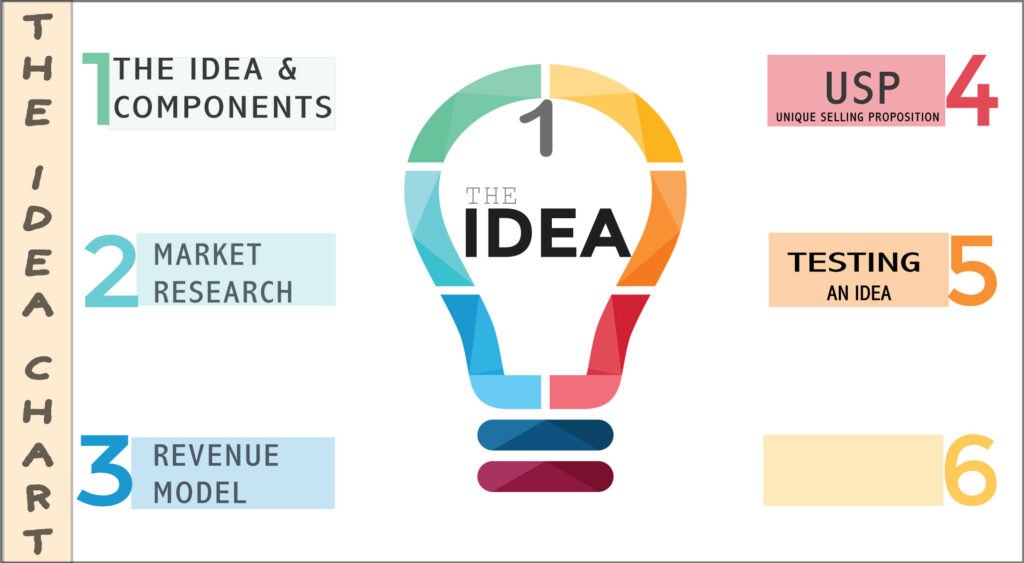- Idea To Profit Series: The Ultimate Guide
- Idea To Profit Series: The Idea And It’s Components
- Idea To Profit Series: Market Research
- Idea To Profit Series: Revenue Model
- Idea To Profit Series:Unique Selling Proposition
- Idea To Profit Series: Testing An Idea
- Implementation, Next In The Idea To Profit Series
Testing an idea is the fifth installment in the Idea To Profit series. Above all, turning a great idea into a business that’s profitable can be a unique journey. Still, there are components to starting a business that’s standard. The goal of this series is to share the ideal steps for turning an idea into a profitable business.
A Brief Recap
So far, we’ve shared four common elements. For example, in the first installment also the introduction, we mentioned the reality of starting a business and the characteristics needed to succeed. Without a doubt, starting a business is common. What’s not common are those who are successful in their efforts. It’s important to remember one point: Entrepreneurs are not born. But, through determination, wit and a willingness to succeed, they achieve their goals.
The second installment of the series focused on the components and serve as a roadmap to the first part of the series. Take a moment and review the roadmap. Now, here is the fifth installment focusing on testing an idea and why it is important.
As we’ve already shared, starting a new business is an exciting endeavour. Thrilling because of the possibilities. However, this venture also carries inherent risks. Many aspiring entrepreneurs have brilliant ideas and grand visions for their ventures. Unfortunately, not all succeed. One crucial step that significantly increases the chances of success is testing an idea thoroughly before launching a business. Startup statistics show about 90% of startups fail. There are plenty of other reasons businesses fail. The biggest is misreading market demand, says CBInsights. This supports why testing an idea before going all in is so crucial.
More On Why Testing A Business Idea Matters?
As you will read below, there are many reasons testing an idea is important. It’s imperative for entrepreneurs trying to turn an idea into a profit to test the idea before implementing a business structure. With every effort taken to ensure an idea is workable, ultimately, the goal is to establish that the idea can stand up to real world demands. Also, to certify the idea is filling a need. In addition, testing highlights potential pitfalls. This allows an entrepreneur the chance to find a solution before execution. Here are five definitive reasons this is a crucial step.
Validates Market Demand
One of the primary reasons to test an idea is to legitimate the demands of a prospective market. It is crucial to determine if there is a genuine need or desire for a product or service in the marketplace. Conducting market research that includes efforts such as surveys and focus groups helps entrepreneurs gather valuable insights from potential customers. It’s also the goal to understand their needs, preferences, pain-points, and willingness to pay. This helps entrepreneurs refine their implementation processes and tailor them to meet the needs of a target market. This validation step is crucial to avoid the common mistake of building a product or service that’s not practical or that no one would want. Validation saves precious time, resources, and effort toward turning an idea into profit.
Determines The Competitive Landscape
Testing your business idea also enables gauging the competitive landscape within a target market. Understanding the existing competition is essential to gaining a competitive advantage. By analyzing competitors’ strengths and weaknesses, entrepreneurs can identify opportunities for creating a contrast. Also to develop strategies to position a business favorably. This analysis reveals potential barriers, which can also provide valuable insights to solve the problem. This advantage allows the entrepreneur to make informed decisions about the feasibility and viability of a business idea. Also consider that understanding the competitive landscape is crucial for formulating effective marketing strategies.
Identify Potential Pitfalls
Testing an idea allows identification of potential pitfalls or flaws in a business model. It provides an opportunity to evaluate various factors. Aspects such as pricing, distribution channels, scalability, and profitability. By subjecting an idea to rigorous testing, an entrepreneur can uncover weaknesses and challenges that may not initially be noticeable. Identifying and addressing these issues early-on significantly reduces the risk of costly mistakes. This is helpful once the business is in an implementation phase. In addition, it also allows entrepreneurs to refine and optimize their strategies to increase the likelihood of long-term success.
Gain Customer Insights
Testing an idea provides invaluable customer insights that help shape a product or service. Entrepreneurs can gather feedback, suggestions, and critiques by engaging with potential customers. Engagement happens through surveys, focus groups, or prototype testing. This direct interaction with the target audience allows for a deeper understanding of consumer preferences, pain-points, and expectations. Armed with this knowledge, entrepreneurs can make informed decisions about product features, pricing, branding, and marketing strategies. Understanding the customer’s perspective is crucial for creating a product or service that resonates with the target market.
Mitigates Financial Risks
Launching a business without testing the idea can be financially risky. Without validation, entrepreneurs can invest significant capital into developing a product or service that ultimately fails in the market. Testing helps mitigate this risk by providing real-world feedback and data that informs decision-making. Offset these risks by conducting market research, testing prototypes, and analysing customer feedback. This helps entrepreneurs make informed financial decisions, allocate resources wisely, and adjust their business model accordingly. The end-result is a reduction in the financial risk of launching a new business. Also remember that reducing financial risks increases the likelihood of securing funding or attracting investors who see the potential in a well-tested and validated business concept.
Methods for Testing An Idea
Now that we’ve shared the importance of testing an idea, let’s delve further into the methods used for testing. We’ve already mentioned that testing allows an entrepreneur to gather feedback. Also to validate the idea and make informed decisions before implementation. Here are further details on the various techniques available to test an idea. Any of these methods can offer unique insights and advantages for a potential idea to profit scenario. Using one are all can contribute to the overall success of an entrepreneurial journey.
Surveys and Questionnaires
Successful businesses use surveys and questionnaires for testing a product or services added to a business. They also use it to gather measurable and conditional data from a sample population. In addition, the process usually involves creating targeted questions to better understand customer preferences. This includes product features, pricing expectations, and more. Because of online platforms such as social media, it’s easier than ever to distribute surveys that reach a wider audience. Also, surveys and questionnaires provide valuable market research data that helps validate an idea. This process helps to identify potential customer segments and refines how a business operates based on feedback from the surveys.
Focus Groups
You can also test an idea using focus groups. This process involves gathering small individuals who fit a target market profile. Further, the goal is to discuss and provide feedback on a business idea. Indeed, this method allows for in-depth discussions, idea generation, and identifying potential issues that may not be apparent in a survey. The interactive nature of focus groups facilitates a deeper understanding of consumer perceptions, preferences, and concerns. It additionally provides a platform for participants to share their opinions, ask questions, and engage in dialogue. This offers a rich insight into the needs and desires of a target market. A business can conduct focus groups in-person or online, allowing for geographic flexibility. The feedback received from these groups can be invaluable. In fact, feedback can shape a product or service by refining marketing messages and identifying areas for improvement.
Minimum Viable Product (MVP)
Another way to test an idea is to develop a minimum viable product (MVP). This is a popular and effective method for testing an idea, particularly for startups and tech-based ventures. An MVP is a scaled-down version of a product or service that includes only its essential features. By releasing the MVP to a limited audience, a business or an entrepreneur can gather user feedback, measure engagement, and identify areas for improvement. This approach allows for continuous development and refinement based on real-world usage and customer feedback. The advantage of an MVP is that it reduces the time and costs associated with developing a full-scale product before knowing if there is market demand. It also provides an opportunity to validate assumptions, test critical functionalities, and gather user-data that enables further product development and business decisions.
Landing Pages and Pre-orders
Creating a landing page with a compelling value proposition and collecting pre-orders is another effective method for testing an idea. A landing page is a dedicated webpage that presents a business concept, highlights its benefits, and captures visitor information. A business or an entrepreneur can gauge interest and measure conversion rates by driving targeted traffic to the landing page through online marketing efforts. This method validates market demand and helps determine pricing strategies and marketing effectiveness. In Addition, this technique provides valuable insight into the willingness of potential customers to commit to purchasing a product or service. Also, this is one way to generate initial revenue and yet another way to provide crucial validation when seeking funding or investment.
Prototyping and User Testing
Creating prototypes and conducting user-testing is also a crucial method for businesses that involves tangible products. Prototypes allow potential customers to interact with a product’s physical representation or working model. User-testing involves observing and collecting feedback as they interact with the prototype. This method helps identify usability issues, design flaws, and areas for improvement. It also provides valuable insights into user preferences, pain points, and expectations. Prototyping or user-testing allows a potential business to refine a product and enhance its user-experience. This method is usable at various stages of a product development, which ensures a final product that meets the needs and expectations of a target market.
Customer Interviews
Customer interviews are a subjective research method that involves one-on-one conversations with potential customers. These interviews provide an opportunity to gather detailed insights into customer behaviors, needs, and motivations. An entrepreneur can uncover valuable information that enlightens a business strategy by asking open-ended questions and actively listening to the responses. Customer interviews allow a deeper understanding of the context of a product or service, the challenges and desired outcomes. This method also helps to identify pain points, validate assumptions, and refine a value proposition based on direct feedback from potential customers.
The Standards for a profit-making business idea?
Evaluating the profitability of an idea is a crucial step in the entrepreneurial journey. By carefully evaluating market factors, financial feasibility, and operational functionality, entrepreneurs can make informed decisions, increasing the possibility of success. Conducting thorough market research, developing a robust financial plan, and analyzing operational requirements provides the foundation for a new business’s potential to thrive. With the following benchmarks and indicators, aspiring entrepreneurs can navigate the path towards a profitable business venture.
1. Market Analysis
Conducting a comprehensive market analysis is a fundamental part of evaluating a business idea and its potential to be profitable. An analysis involves examining the target market, understanding customer needs and preferences, and awareness of the competitive landscape. Consider the following reference points and indicators during this analysis:
Market Size
Consider the size of the target market and its potential for growth. A large and expanding market shows more significant opportunities for success.
Target Audience
Identify the target audience’s specific demographic, responsiveness, and discernable characteristics. Understanding the customers’ needs and preferences helps tailor an idea into a business that targets the right market segment.
Competitive Advantage
Evaluate the existing competition and identify unique selling points or competitive advantages that help a new business stand out from the competitors. A viable business idea should offer something compelling and valuable that makes it stand out.
2. Financial Feasibility
Appraising the financial feasibility of an idea is crucial to ensure its long-term sustainability. These benchmarks and indicators can aid in determining the financial growth entrepreneurs can use as an indicator.
Cost Structure
Analyze the costs associated with starting and operating the business, including overhead costs, production expenses, marketing expenses, and personnel costs. Also, ensure that projected revenue can cover these costs while maintaining profitability.
Revenue Streams
Identify potential revenue streams, such as product sales, subscriptions, licensing, or advertising. It’s best to evaluate the viability and growth potential, to ensure sufficient income generation.
Profitability and Return on Investment (ROI)
Continuously examine financial statements, including income statements, balance sheets, and cash flow statements, to appraise profitability. This includes a timeline for achieving positive cash flow and return on investment. With an optimistic financial projection, show the viability of the business idea.
Funding Opportunities
Determine the availability of funding sources, such as personal savings, loans, investments, or grants. Gauge the feasibility of securing adequate funding to support the business idea during its initial stages and potential growth.
3. Operational Viability
The operational aspects of an idea play a crucial role in determining its viability. The following benchmarks and indicators can help to estimate operational feasibility.
Resources and Infrastructure
Evaluate the resources, including human capital, equipment, technology, and physical infrastructure. All of which are required to bring an idea to fruition. Confirm these resources are available and easily accessible within a reasonable timeframe.
Scalability
Consider whether the idea has the potential to scale and grow over-time. Evaluate whether the operational processes are easy to replicate, expand, or change to accommodate growth. This should happen without compromising quality or efficiency.
Legal and Regulatory Considerations
Be aware of and understand the legal and regulatory requirements associated with the proposed idea. Compliance with laws and regulations is essential to avoid legal issues or derailing of the venture once implemented.
Summary
Testing an idea is a critical step in the entrepreneurial journey. It plays a pivotal role in validating market demand, assessing the competitive landscape, and identifying potential pitfalls. It also allows entrepreneurs to gain customer insights and mitigate financial risks. By subjecting an idea to rigorous testing and analysis, the entrepreneur can refine the concepts, optimize strategies, and increase the likelihood of long-term success. Testing also provides a solid foundation for building a foundation for a customer-centric and financially sustainable venture. Ultimately, investing time, effort, and resources in testing an idea is a worthwhile endeavour that significantly increases the chances of turning an idea and vision into a thriving reality.



















